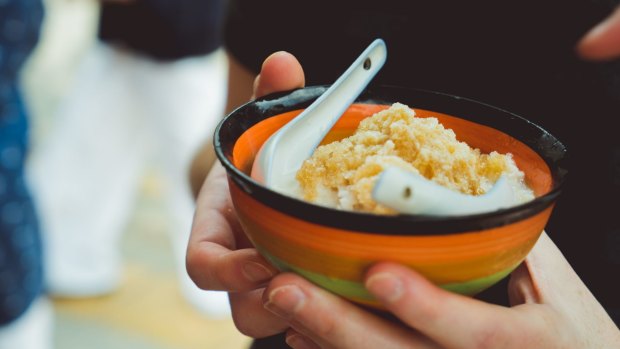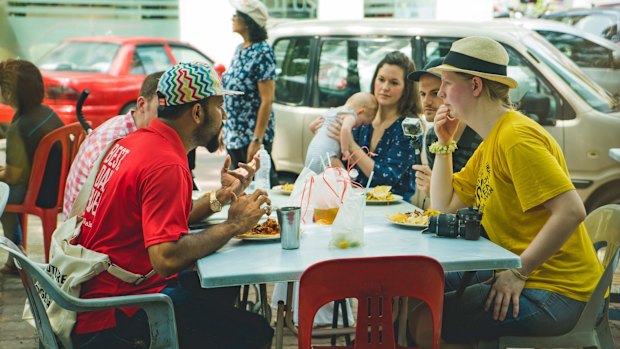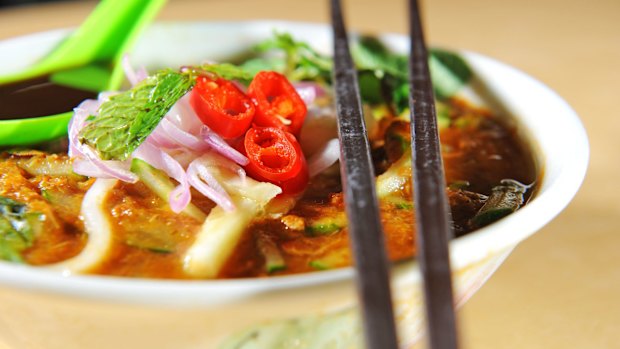This was published 4 years ago
Urban Adventures' food tour of the Pudu district of Kuala Lumpur
By Brian Johnston

Bowl of Ais Kacang.Credit: URBAN ADVENTURES
The taxi driver is perplexed when he hears I want to go to Pudu. Pudu is a working-class neighbourhood, he warns. It's down-at-heel, the sort of place where people take buses, not taxis. It isn't on the standard tourist trail in Kuala Lumpur. It's not for someone, he seems to imply, who is staying at the Mandarin Oriental Hotel, which he describes as posh.
But this is exactly why I'm going to Pudu. Posh is the same everywhere. In the KLCC area of my hotel, posh is air-conditioned shopping malls and glass-encrusted office towers. It's not there but in ordinary places that you get an insight into any city, and a taste of local life. That is quite literally what you get on this Urban Adventures tour, with a progressive breakfast in Pudu's wet market and neighbourhood eateries.
I'm meeting my guide at Pudu metro station, where there are no tourists hauling suitcases and no Starbucks outlets, just a vending machine selling soy-bean milk and tamarind cookies, and locals hurrying towards work in neatly ironed shirts or headscarves.

Tucking into street food.Credit: Urban Adventures
Ken Chuah is no longer among them. He used to work for Hewlett Packard, but quit to lead Kuala Lumpur tours. Pudu is indeed, he says, a working-class neighbourhood. Locals know it for its street food and old-fashioned shops selling plastic buckets or mending bag straps. And yet it's still very central, right beside trendy, upscale Bukit Bintang, the city's entertainment district where overseas tourists congregate over evening cocktails.
In Pudu we have morning kopi cham, Malaysia's odd blend of coffee, tea and condensed milk, which sounds horrid but has a taste reminiscent of hot chocolate. Ken orders up our first courses in this progressive breakfast: laksa with tofu and beansprouts, the toast with coconut jam and butter of which locals are so inordinately fond, and noodles with barbecued pork.
We're in an alley with a row of stalls run mainly by Cantonese speakers. Red-and-gold Chinese characters are plastered on the walls. We sit on plastic stools with our knees around our ears. The table top is cluttered with red plastic bowls and pink chopsticks. Kuala Lumpur's humidity is already pressing down, infused with a dose of traffic fumes and oily wok smoke.

Bowl of laksa.Credit: Tourism Malaysia
This certainly isn't posh, but my laksa is rich in flavour, and noodles are made on the spot with a pasta machine clamped to the edge of a table. The chef is chopping chillies with a giant cleaver, bang! bang!, as he watches football on television. Housewives push past with shopping bags already loaded with greens and mangoes.
Chinese alleys are the best bet if you're an adventurous eater, says Ken. The owner is typically in charge of the tables and rents each stall to hawkers, so you generally find each stall serves something different. Malay street food, on the other hand, is often found indoors in centres built by the city council. It might have 10 stalls all serving the same thing.
Malaysian food is a fusion of Malay, Chinese, Indian and European influences, but Moslem Indian or mamak food (mamak means "uncle" and is a polite Malay form of address) is the most popular cuisine.
"That's because it's halal and there's no pork, so everyone can eat it. It's tasty but not really spicy like north Indian food. So mamak restaurants are one of the few places where you'll find all three ethnic groups mixing," says Ken.
Later we stop by a mamak eatery for some hot roti and appam, a crispy Indian pancake made from fermented rice batter, with coconut chutney as a side. Ken also introduces us to roti kaya, a roti bread with coconut jam cooked into it. He calls it the poor man's breakfast, but it's delicious.
Malaysia is a foodie's delight for its flatbreads and pancakes alone. There are dozens of varieties, fat and thin, rolled-up, coloured yellow with turmeric or green with pandan, savoury and sweet. Later in the market we stop at a stall for apam balik, a pancake cooked in a hot pan with butter, and stuffed with sugar and crushed peanuts.
Pudu Wet Market is 70 years old and one of the largest left in Kuala Lumpur. It's not posh, either. It's rowdy, hot and cacophonous. A reputed 1500 stalls are squeezed into a hanger and a surrounding open-air square. It's unusual for its ethnic mix of businesses. The Chinese are hacking up pork, the Moslems are sawing at beef bones, the Hindus are slaughtering chickens. Malay ladies deshell clams with a staccato click-click.
In posh places, I'd see only hamburgers and French baguettes and expensive Caesar salads in same-same cafés. Here I see Indian bitter gourd, buckets of wiggling toads, catfish gulping on steel trays, salted duck eggs, black-skinned chickens used to make Chinese medicinal soup. I can sniff at moringa seeds and Sabah snake grass and the stinky beans supposed to be good for your health.
I try some fresh mangosteens. They're often banned in hotels in Malaysia – along with the infamous durian, whose reek would fell a water buffalo – because their purple juice can leave indelible stains. It spurts out as you crack open the leathery shell to get at the mangosteen's plump, white, utterly delicious flesh.
Around the edge of the market are interesting shops. Coconuts are delivered by the truckload to Kim Kee, trundled inside in wheelbarrows and grated on clanking old machines. Nearby, Hon Soong sells salted fish stiff as cardboard, and anchovies, some types to eat with porridge, others to accompany the national dish, nasi lemak. There is, unaccountably, a street devoted to electronic stores inside which immigrant workers from Bangladesh lurk, touting fake Viagra pills.
Do I have room for nasi lemak? Of course I do, it's one of my favourite Malaysian dishes. Malaysians mostly eat it for breakfast, so now is the time. ("Malaysians only eat once a day," jokes Ken. "But we start in the morning and don't finish until night time".) We stop by a stall and soon it's served up on a plastic green plate. The coconut rice is creamy and sweet, surrounded by slices of boiled egg, fried peanuts and anchovies, and of course spicy sambal.
This is the pure traditional variety, according to Ken. Sometimes it comes with chicken, beef rending or squid. The Indians have it with curry, the Chinese with minced pork. And no, it isn't posh food, but it's worth a journey.
TRIP NOTES
FLY
Malaysia Airlines flies from Adelaide, Darwin, Melbourne, Perth and Sydney to Kuala Lumpur. Phone 13 26 27, see malaysiaairlines.com
TOUR
Urban Adventures runs day tours in 152 destinations worldwide, during which local guides help you explore cities away from the tourist trail. It has three tours in Kuala Lumpur, including a 2.5-hour "Market Tour" from $84.50 including guide and food. See urbanadventures.com
STAY
Mandarin Oriental Kuala Lumpur has a great location near Petronas Twin Towers, excellent restaurants, outdoor pool, tennis courts and an expansive spa. Club Rooms from $309 per night have access to one of Asia's best club lounges. Phone 1800 123 693, see mandarinoriental.com
MORE
Brian Johnston was a guest of Peregrine Adventures, Mandarin Oriental Hotels and Urban Adventures.
Sign up for the Traveller Deals newsletter
Get exclusive travel deals delivered straight to your inbox. Sign up now.